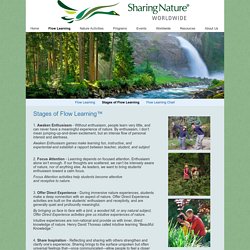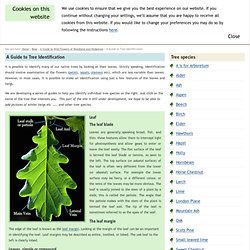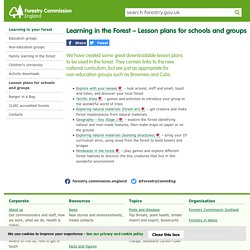

Story Telling. Active learning. It's More Than Just a Stick.... or a Carrot! Discussion The statistical analysis of the results shows that those students who received bushcraft tuition did outperform those who did not receive bushcraft tuition.

Stages of Flow Learning™ - Sharing Nature Worldwide. 1.

Awaken Enthusiasm - Without enthusiasm, people learn very little, and can never have a meaningful experience of nature. By enthusiasm, I don’t mean jumping-up-and-down excitement, but an intense flow of personal interest and alertness. Awaken Enthusiasm games make learning fun, instructive, and experiential-and establish a rapport between teacher, student, and subject 2. Capital Growth: London's food growing network. Forest School Education Theory.
Dictionaries and Reference Tools. Forest School in Practice. Forest School Association Conference. Forest School Course Materials/Resources. Forest Schools. Annual growth rings Tree knowledge Booklet Forest Academy Domtar. Wilderness Skills. What is an Outdoor Classroom? Md. Evaluation of Forest School: Phase 2 - England. Summary Phase 2 of the Forest School evaluation focused on three case study areas in England: Oxfordshire, Worcestershire and Shropshire.

The objective was to explore the benefits and impacts of Forest School on children over an extended period of time. The key features and themes of Forest School that emerged from an analysis of the data are outlined below. The evaluation was participatory and involved workshops with key stakeholders who developed six specific positive outcomes that related to children’s self esteem, ability to work with others, motivation to learn, language development, skills and knowledge and physical skills development. Resources. Pajure. Why Choose an Outdoor Classroom? Research in education. Old-Fashioned, Pioneer & Primitive Skills & Resources. A Guide to Tree Identification. It is possible to identify many of our native trees by looking at their leaves.

Strictly speaking, identification should involve examination of the flowers (petals, sepals, stamens etc), which are less variable than leaves. However, in most cases, it is possible to make an identification using just a few features of the leaves and twigs. We are developing a series of guides to help you identify individual tree species on the right. Just click on the name of the tree that interests you. This part of the site is still under development, we hope to be able to add pictures of winter twigs etc ….. and other tree species. Leaf The leaf blade Leaves are generally speaking broad, flat, and thin: these features allow them to intercept light for photosynthesis and allow gases to enter or leave the leaf easily. The leaf margin The edge of the leaf is known as the leaf margin. Leaves, simple or compound. Outdoor Classrooms. Forest school. All about forest schools. Urban Organic Gardener.
Forest School in practice. Outdoor Classrooms on Social Media! All about forest schools. Primary Curriculum 2014. www.forestry.gov.uk/pdf/AguidetoForestSchools09.pdf/$FILE/AguidetoForestSchools09. Infinite PlaygroundsInfinite Playgrounds. Ultimate Camp Resource - Camp Games, Camp Songs, Camp Skits. Outdoor Learning. Are children losing touch with nature and does it matter if they are? « Outdoor Nation. Play expert, Bob Hughes, writes about the importance of outdoor play for children with those of their own age Children in the garden at Moseley Old Hall, Staffordshire.

Copyright ©National Trust Images/Arnhel de Serra. It is true that today’s children are not generally as likely to become immersed in, for example, natural play experiences as were previous generations. Until the 1960’s children would have not only have played outdoors but the outdoors would have provided them with the bulk of their play props, and the backdrops for their play narratives. In short, they would not only have played in the outdoors but with the outdoors too.
www.forestry.gov.uk/pdf/AguidetoForestSchools09.pdf/$FILE/AguidetoForestSchools09. Eastwood Urban Forest School. Visual, Auditory, and Kinesthetic Learning Styles (VAK) The VAK learning style uses the three main sensory receivers: Visual, Auditory, and Kinesthetic (movement) to determine the dominant learning style.

It is sometimes known as VAKT (Visual, Auditory, Kinesthetic, & Tactile). It is based on modalities—channels by which human expression can take place and is composed of a combination of perception and memory. VAK is derived from the accelerated learning world and seems to be about the most popular model nowadays due to its simplicity. While the research has shown a connection with modalities and learning styles (University of Pennsylvania, 2009), the research has so far been unable to prove the using one's learning style provides the best means for learning a task or subject. This is probably because it is more of a preference, rather than a style. Learners use all three modalities to receive and learn new information and experiences. According to the VAK theorists, we need to present information using all three styles. VAK Learning Styles Survey. Note: Please read the Introduction as it brings up some important points about learning styles.

To learn more about VAK please read, Visual, Auditory, and Kinesthetic (VAK) learning styles. This survey is designed to help you gain an understanding of learning styles so that you can incorporate the various learning styles in your daily learning activities. It is NOT meant to show you your best way of learning as the research does not promote it. Rather, it is a tool for learning-to-learn (metalearning) that increases self-awareness about your strengths and weaknesses. This will help you will to try the various styles of learning so that you may choose the best one for the situation, rather than sticking with your preferred methods. For a learning style survey based on the two continuums of Processing and Perception, see the Learning Style Survey. VAK Survey Read each statement carefully. Answer honestly as there are no correct or incorrect answers.
Outdoor maths. Reviewing by Doing: article by Dr. Roger Greenaway. Wilderdom - a project in natural living & transformation. Survival. Free Books: Homesteading & Survival. Cardboard & Paper Furniture. Your place to share nature. WfsURBANGUIDE.pdf. Some useful links. Learning in the Forest – Lesson plans for schools and groups. We have created some great downloadable lesson plans to be used in the forest.

They contain links to the new national curriculum, but are just as appropriate for non-education groups such as Brownies and Cubs.